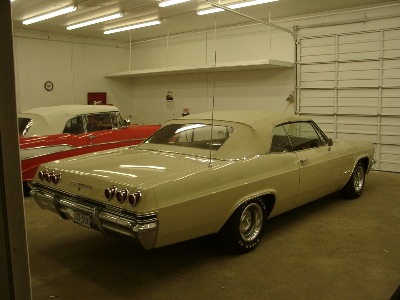

 | |

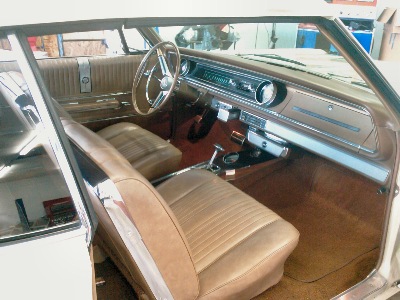 Our 1965 Impala SS396 is an unrestored beauty with 44,000 original miles. The car is optioned with power steering, power brakes, power windows and an AM/FM radio with front and rear speakers. We have all the original documentation for the car including the famous "Protect-O-Plate". If you are interested, below the pictures is a brief history of the 396 V-8 affectionately known as the "Porcupine" engine.
Our 1965 Impala SS396 is an unrestored beauty with 44,000 original miles. The car is optioned with power steering, power brakes, power windows and an AM/FM radio with front and rear speakers. We have all the original documentation for the car including the famous "Protect-O-Plate". If you are interested, below the pictures is a brief history of the 396 V-8 affectionately known as the "Porcupine" engine.
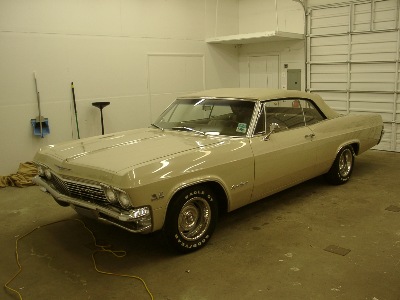
This car is now lovingly owned by an amazing Chevy collector out in Los Angeles. She is putting together a terrific collection of these vintage cars.
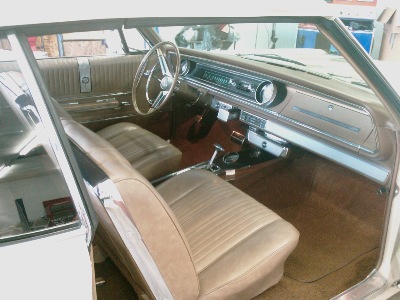
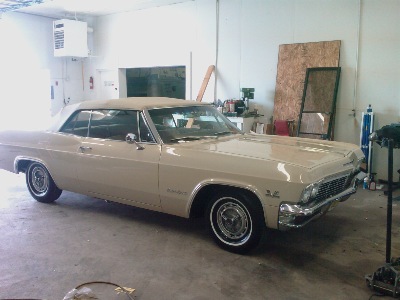
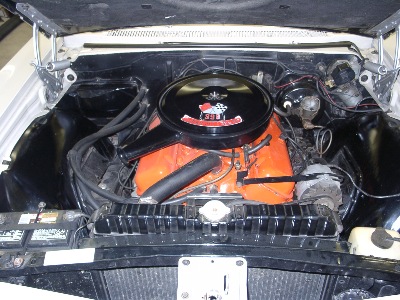
(Borrowed from How Things Work)
Early in 1963, a mysterious new
Chevrolet 427 V-8 appeared at Daytona International Speedway. After being shocked by its
acceleration and speed, rivals who were able to look at it with the
rocker covers off noticed its odd valve angles, and nicknamed it the
"Porcupine" engine. In the 500-mile race, the Chevy simply sped away,
leaving all other cars behind, and lapped at average speeds up to 166
mph before dropping out-due to unspecified engine failure. Shortly
after that, GM's top management put a ban on racing activities by its
car divisions, and no more was heard of the "Porcupine." However,
development work on it continued unabated at the GM Technical Center in
Warren, Michigan. It resurfaced in the spring of 1965 as a
high-performance option for the, Chevelle the full-size Chevrolet, and the Corvette, with capacity to cut 396 cid.
Design and development work on the "Porcupine" is credited to a team
consisting of Richard L. Keinath, assistant staff engineer; Herbert G.
Sood, project engineer; and William J. Polkinghorne. Keinath had helped
Don McPherson design the four-and six-cylinder ChevyII engines in
1960-1961, and had been working on V-8 projects since then. He had
joined General Motors in 1950, arriving at Chevrolet in 1956. However,
the idea for the "Porcupine" valvetrain and overall engine design came
from Robert P. Benzinger, who had laid out and detailed the
all-aluminum Corvair flat six, and was gaining recognition among
Chevrolet's technical staff as Division's top engine man.
What was new and unusual about the valve gear was that it resulted
from working "backwards." Normally, an engine designer starts with the
combustion chambers, and arranges the valves so they can be operated by
simple, straightforward mechanisms. Benzinger felt that better results
could be obtained by giving attention to breathing rather than just
locating mechanical parts. Accordingly, he started with the ports and
manifolds, giving the ideal dimensions and gas flow paths, and left the
valves till later. Valves are happy enough working at almost any angle,
but what about the pushrods? They can't be bent, but must go straight
from the lifter to the rocker arm. With very few compromises, Benzinger
poked the pushrods through little openings to the oddest places-and the
whole thing worked superbly well.
Intake valves were set at an angle of 26 degrees to the cylinder
axis, and exhaust valves were tilted 17 degrees from the same axis.
That wasn't all, for both intake and exhaust valve stems were also
tilted in side view, one forwards and the other backwards, by 9
degrees. This lined them up with the pushrods to avoid setting up any
rotation in the rocker arms. This basic cylinder-head configuration was
then tested, fiddled with, honed, and polished until it provided
optimal breathing. That part of the design was then frozen, and all
other components were designed around it.
Chevy 396-cid V-8 Engine Overview
The 396 V-8 was just one member of a whole "Porcupine" family,
officially titled Mark IV and marketed as the "Turbo-Jet." There were
four in all: two high-performance car engines of 396 and 427 cid, a 366-cid heavy-duty truck unit, and a 427 heavy-duty marine version. The 396 was scheduled to replace the 409
in all its applications, even though that engine was hardly old. Why
was it scrapped after barely five years' production? Aside from its
basic design limitations, the type W had been tooled for relatively low
production volume. To meet future demands, Chevy's Tonawanda, NY
plant (near Niagara) would have to be retooled anyway. Semon E.
"Bunkie" Knudsen, then division general manager, decided that only the
most modern engine could justify such a major tooling reinvestment, so
the "Porcupine" got the nod.
There was no thought of any carryover from the type W or 409 to the
Mark IV. An all-new block with 4.84-inch spacing between bore centers
was chosen, giving a bore of 4.094 inches. Stroke as 3.76 inches.
The 409 had a deck angled at 33 degrees from horizontal to allow a
wedge-shaped combustion chamber to be created with flat-faced heads. By
contrast the Mark IV block had the usual deck angle of 45 degrees to
the cylinder axis. Main bearings were 2.75 inches in diameter, a
quarter-inch larger than the type W. Main-bearing width was also
increased, adding two full inches to the cap-clamping surface. The
forged-steel crankshaft was cross-drilled to deliver oil to the rod
bearings through a full 360 degrees of rotation (a feature the W
lacked), and crankpin journals were kept at 2.20-inch diameter.
The 396 was initially offered in two versions, both with four-barrel carburetors,
10.25:1 compression, and hydraulic filters. One was rated at 325 bhp,
the other at 360. Production began at mid-year 1965 at the Tonawanda
plant where all Mark IVs were built. There was also a 425-bhp version
listed as a Corvette option that year. It had a 11.0:1 compression, impact-extruded alloy
pistons with chrome-plated rings, solid lifters, bigger carburetors
with twin-snorkel air cleaner, and enlarged oil pan capacity. This
engine was in very short supply, but it wasn't short on performance.
With it, a car geared for a top speed of 140 mph could blast through
the standing-start quarter mile in 14 seconds flat at a terminal speed
of 102-104 mph.


